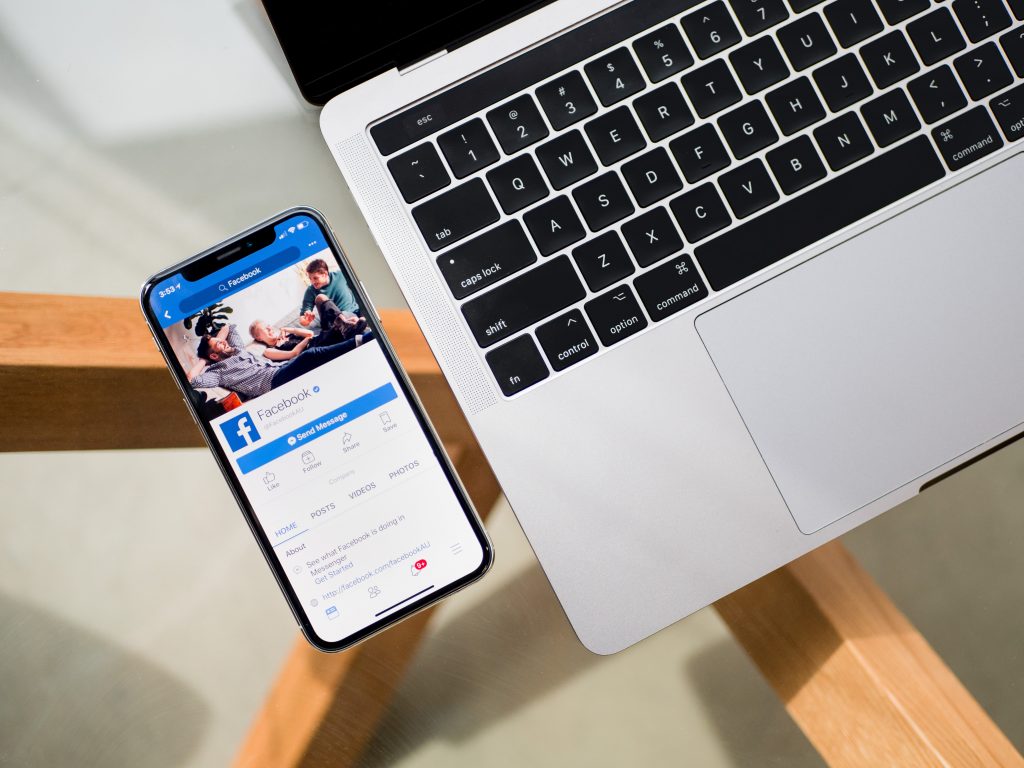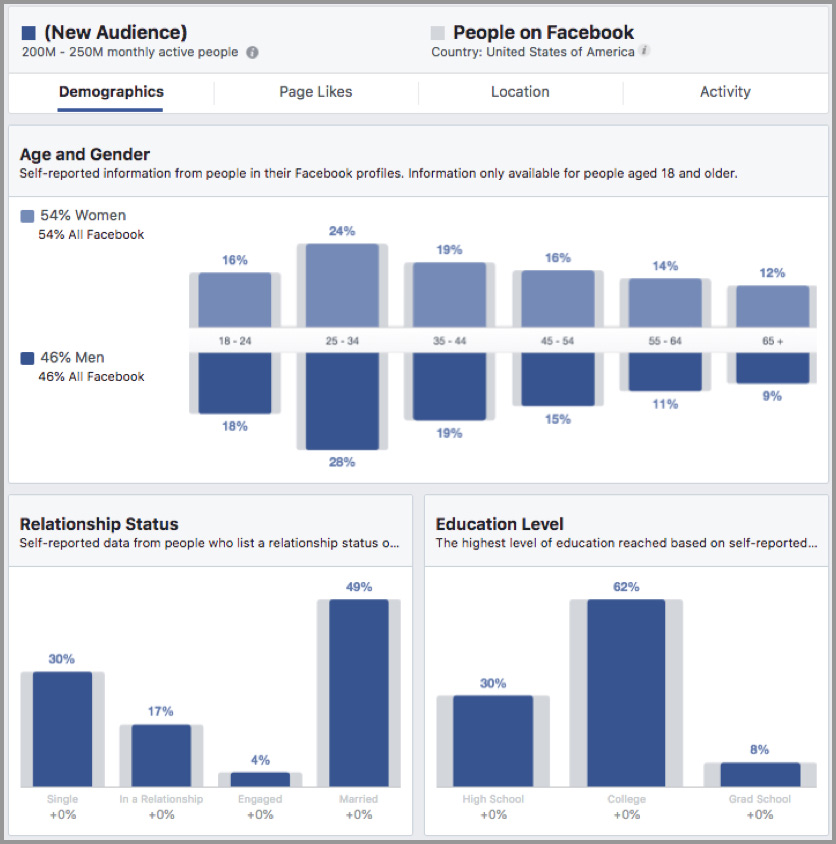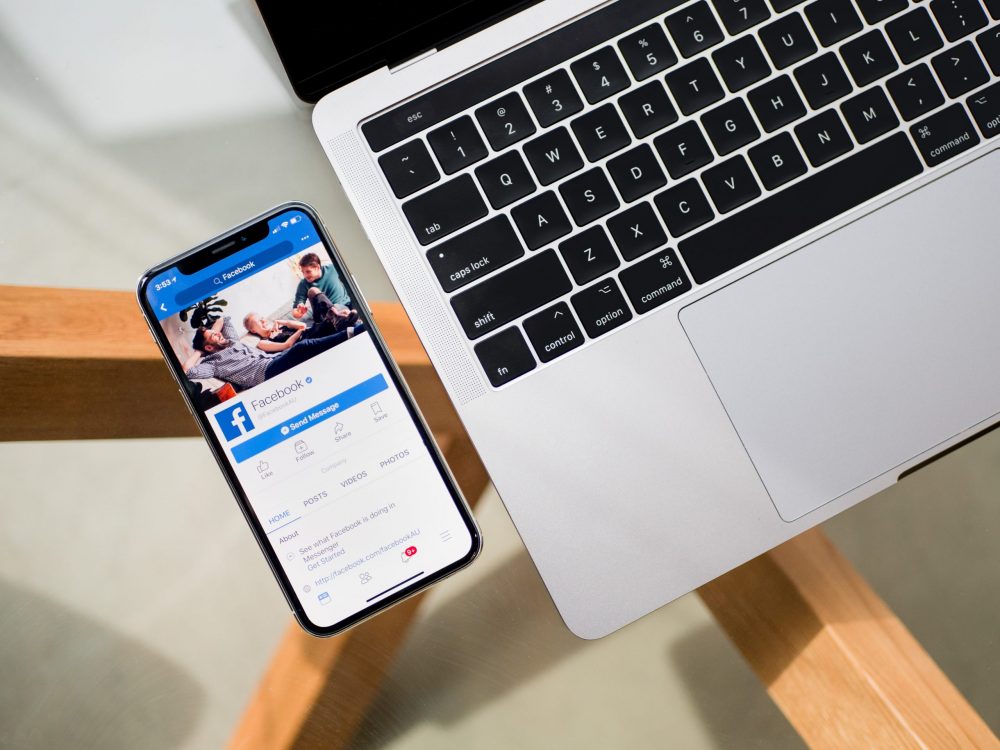It’s likely that a good portion of your target audience uses Facebook – here’s how to best connect with them on the social media platform (and why you should).
Here, you’ll find:
- How to leverage Facebook marketing in the wake of privacy updates
- Tips to effectively segment and target lookalike audiences
- How to optimize Facebook audience targeting with creative and messaging
- Why your ad’s first sentence is the most important
Have you ever scrolled through a Facebook page and seen an ad so irrelevant to you that it made you laugh? For example, an ad for baby clothes when your youngest kid is heading to college.
Well, with tech companies like Apple cracking down on user privacy in the past few years, Facebook has pivoted to erase user data and behavior that doesn’t meet these new privacy guidelines.
Plus, Facebook ad targeting options like religious and political affiliations are no longer available. A host of other ‘sensitive’ options have been removed as well, such as ties to charitable or environmental organizations. Even seemingly random interests, like first aid or skin care, are now off the proverbial table.
For businesses investing in social media marketing, the Facebook advertising space has turned into the Wild West. That means you’ve got to employ the right messaging if you want to find and target your audience effectively.
Luckily, there are still ways to connect with potential customers in the market for your product or service on this social network. The key is knowing how to target them while following all the right guidelines.

Image: Unsplash
How do you target an audience on Facebook properly?
For starters, Facebook says it can automatically show your ads to the people most likely to find them relevant. From there, you have three different audience selection tools at your disposal:
- Core audiences
- Custom audiences
- Lookalike audiences
Core audiences
Core audiences are pretty straightforward: they’re defined by various criteria ranging from a broad to hyper-specific audience. This includes:
- Location
- Demographics (age, job title, etc.)
- Interests and hobbies
- User behavior (past purchases, devices used)
- Connections (people who have “liked” your event or Page on Facebook)
Custom audiences
Facebook custom audiences are people already familiar with your brand and its offerings. Maybe they’ve downloaded your app, visited your website, or are existing customers. These can be effective retargeting (or remarketing) opportunities.
You can create custom audiences with groups that fall under categories such as:
- Contact lists from your customer relationship management (CRM) platform, email list, or in-store customer list, if applicable
- Site visitors that your Pixel shows as having visited your website and/or taken certain actions
- App users who have downloaded your app, taken a certain action within the app, made an in-app purchase, etc.
Lookalike audiences
Many advertisers have found new ways to reach consumers, but others are still struggling to find their target audience on Facebook.
If you fall into that second category, experience has shown us one Facebook audience targeting strategy that’s remained very powerful is lookalike audiences.
So, what is a lookalike audience, exactly? It’s built off the demographics of your current engagers. You provide Facebook with a list of active customers or email subscribers, and it will find users with similar interests and purchase behaviors.
Because you build lookalikes from folks already familiar with your brand, they also become very qualified audiences.
This is especially worthwhile for e-commerce brands with multiple product categories because you can create lookalike audiences based on users who have purchased certain products. That means you can separate bathtub buyers from kitchen sink buyers and create specific ads to reach lookalikes of each.

Image: Facebook
How to qualify lookalikes into your ideal audience
This just the tip of the iceberg. Facebook audience targeting becomes a doubly powerful tool when you customize your creative to address the pain points of each lookalike segment.
Look at it this way: If you were putting together a restaurant menu, you probably wouldn’t include just one dish. If you did, then you’d attract only the folks that like that specific food. This would, of course, greatly narrow your audience.
Instead, a restaurant focused on growth and success will offer a variety of dishes to appeal to all the different people you want to visit your restaurant. Building advertising creative works in much the same way. Your efforts garner better results when you tailor them to multiple ideal audience segments.
Not only that, but running one-size-fits-all creative assumes that your audiences have the same pain points and desires, which isn’t usually accurate or effective.
Instead, you can customize your message to folks searching for bathtubs vs. those searching for kitchen sinks, for example.
There are two main points to consider when building creative for each of your audience segments:
- What drives their purchase behavior?
- What are the most relevant value propositions for these audiences?
When apparel brand 686 came to us looking for help meeting their ecommerce sales and marketing ROI goals, we created optimized paid search and remarketing campaigns (including on Facebook) to help them stand out and better connect with their target audience. As a result, 686’s year-over-year SEM revenue increased by a whopping 562% with a profitable return on ad spend. Here’s how we did it.
How to create a custom audience on Facebook
The steps to creating a custom audience on Facebook are relatively simple, but let’s get a few reminders out of the way first.
Globally, Facebook audience targeting demographic options for people under 18 are limited to location, age and gender only. Detailed targeting, custom audiences, lookalike audiences and saved audiences can’t be used to target users that fall within this age range.
What’s more, your website’s custom audience may not paint a complete picture because of Apple’s iOS 14 privacy policy around data tracking (more on that below).
Now, to create a website custom audience on Facebook:
- Navigate to “Audiences” in Facebook Ads Manager
- Click the “Create audience” dropdown menu, then select “Custom audience” if you have existing audiences. (If you don’t, you can create them here instead of selecting from the menu.)
- Select “Website traffic,” then set a rule section (standard rules, Pixel event rules, and any additional rules you want to add yourself, up to 5 rule sections per audience)
- Name your audience and add a description (if you want)
- Click “Create audience”
Once you’ve created an audience, you can select it during your next Facebook ad campaign creation process.
Pro tip: Looking to use Facebook audience targeting to increase your conversion rate? Hootsuite recommends:
- Targeting your competitor’s fans using Audience Insights
- Targeting those who have recently shopped via Facebook ads
- Layering your target for a more precise audience
- Finding people similar to your top customers with value-based lookalike audiences
Creating your ideal customer avatar
The first sentence of your ad copy (or the first three seconds of your video ad) are the magic entry point to reach and hook your ideal customer avatar successfully.
For instance, if you’ve built a Facebook lookalike audience from kitchen-sink purchasers and want to ensure you only reach folks relevant to this product, start with a sentence like, “Looking for a kitchen sink that won’t show scratches or rust spots?”
This will catch the eye of qualified viewers, and those who aren’t looking for a sink will scroll right past.
Pairing this with video creative results in an even greater advantage. You can retarget folks who watched that video or create another lookalike audience from the viewers, which will be a hyper-segmented section of folks who have shown interest in that product.
(Hint: That’s an excellent strategy for building lookalikes if you don’t already have past purchasers to source.)

Image: Unsplash
Social media ad best practices for Facebook
No matter which audience sizes and segments you’re speaking to, it’s a social media best practice to center the viewer as the hero of the ad.
Rather than telling your viewer why your brand is so great, campaigns that see the best ad performance demonstrate why the product or service can be the solution to their pain points.
If your audience is remodeling their bathroom and needs a new bathtub, empathize with them about the exhausting nature of home remodeling. Then, you can show how easy your bathtubs are to install. Meet them where they are, and they’ll be more likely to consider your brand.
Facebook has published its own list of tips to make your ad more engaging. They include:
- Use vertical videos and visuals
- Put less text overlay on images
- Leverage the carousel format to include multiple images
- Add movement (hyperlapse, boomerang, Adobe editing features, etc.)
- Use strong calls to action (CTAs)
Pro tip: While Facebook also recommends keeping text short, our experts have seen longer ad copy perform better in many tests, particularly for top-of-funnel audiences.
What to know about the Facebook Pixel (aka Meta Pixel)
If you’ve got experience with Facebook Ads, you probably know about the Pixel.
For the uninitiated, this is a piece of code you add to your website that allows you to, in the social media platform’s words, “measure, optimize, and build audiences for your ad campaigns.”
Consider the Pixel like a little tag you add to someone who clicks your Facebook ad. It can offer audience insight like what actions people take once they get to your site from Facebook, where they drop off, what they add to their cart, and more. This helps you better understand your target audience and is helpful when it comes to conversion tracking as well as, of course, retargeting.
As a result, you can leverage the Pixel to ensure your ads are visible to the right audience members, increase sales, and gather important metrics around campaign performance.
Other key features of the Facebook Pixel include:
- Ad delivery optimization
- Website traffic insights
- The ability to turn website visitors into custom audiences
- Better understanding of cross-channel conversions
As we’ve mentioned before, adding your Pixel is one of the first things to put in place before a campaign launches.
Facebook’s Conversions API
If you’ve had your “boots on the ground” in the digital marketing sphere that past few years, you know there’s been a growing conversation about data and user privacy.
In response, Apple rolled out a new policy feature in April 2021 as part of its iOS 14 update. This update now requires users to opt in to having their data tracked in certain apps (like Facebook). If the user doesn’t opt in, they don’t get tracked outside of the app.
Facebook explains it best:
“Our Meta Business Tools terms require that businesses (or partners acting on their behalf) may not place the Meta Pixel associated with their Business Manager or ad account on websites that they do not own without our written permission. Starting May 5, 2021, we’ll show verified domain owners the events and custom conversions recently received from the Meta Pixel placed on their website. While verified domain owners will see all these events, the only events they can use for ad optimization and reporting are events they can access from their own Business Manager account.”
Luckily, this marketing hurdle can be combated with help from Facebook’s Conversions API (CAPI). With CAPI, Facebook assigns a unique ID to each user who goes from clicking a Facebook ad to arriving at the landing page on your site. It will then log actions taken and report them back to Facebook.
CAPI is similar to the Pixel, except that data is transferred from server to server, eliminating the need for third-party cookies. As an added bonus, some consider CAPI more reliable than the Pixel since it doesn’t hinge on browser performance or cookies. (It’s also not hindered by ad blockers like the Pixel.)
Facebook advertising mistakes to avoid
While there are many areas of opportunity for advertisers on Facebook, there are also plenty of ways to drain your budget without much to show for it, especially in terms of targeting.
Prevent under-performing campaigns by avoiding these missteps:
- Restricting your audience unnecessarily
- Targeting an outdated ideal buyer persona
- Not knowing which type of content or ads your audience prefers
- Not A/B testing your campaign elements
- Having an inconsistent process for campaign creation
- Not choosing the right campaign objective
- Selecting the wrong budget spending option
- Not double-checking your tracking data
Pro tip: If it makes sense for your ad goals and offerings, consider Facebook audience targeting via life events. The platform allows you to target life events such as travel, relationships (like getting married), moving, getting a new job, and more. This way, if you’re a wedding dress shop targeting brides-to-be, your campaigns are more likely to be relevant.
The takeaway
Social media platforms are constantly evolving. (Let’s not even get into the current chaos of Twitter.)
It can be challenging to keep up with all the new policies and regulations. On the bright side, there’s plenty of opportunity when advertisers can connect with potential clients seamlessly and directly.
Conduct Facebook audience targeting using hyper-segmented lookalike audiences and custom creative. When you do, you get a two-pronged approach with people who are extremely qualified and likely to convert.
And once these lookalike campaigns are live, Facebook monitors who clicks and who doesn’t, and uses this information to continually refine its targeting. This can lead to audiences that grow even stronger with time and, ideally, become new customers.

